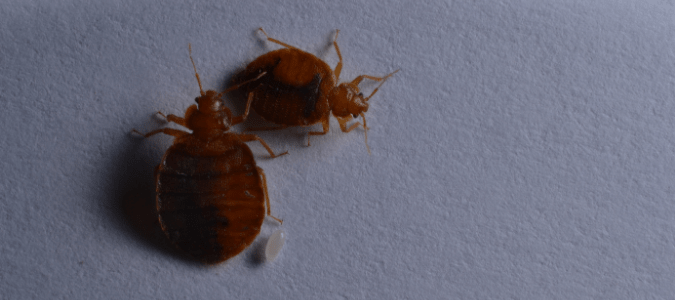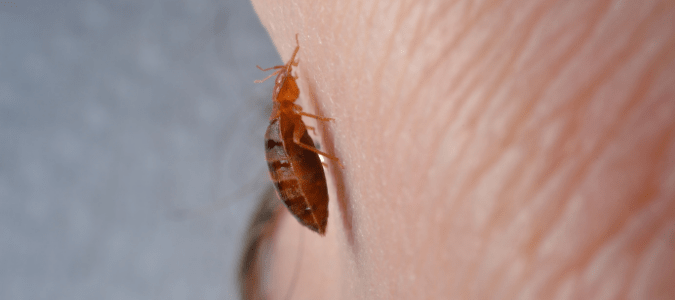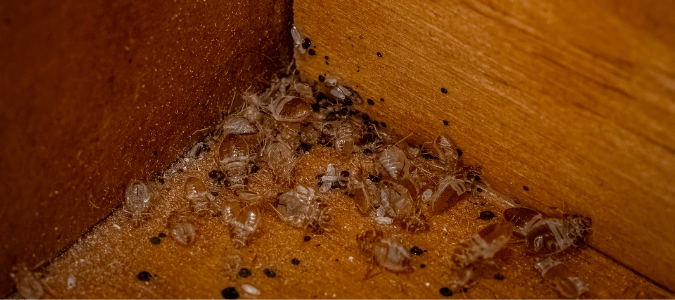If you notice small, itchy bites appearing on your skin or your family’s skin, you no doubt have questions about what is causing them. Maybe you have seen little brownish oval insects flitting around a bed or a couch. Surely these can’t be bed bugs, can they?
Bed bugs do not discriminate when choosing their meal. They go where the food is, and for these little bugs, blood is their food source. Having an infestation doesn’t reflect housekeeping habits. It simply means bed bugs have found their way to a new meal ticket.
Before assuming that bed bugs are your problem, it’s best to get an inspection from a licensed pest control professional. There are a couple of other insects that look similar, including some spiders, carpet beetles, booklice, cockroach nymphs, fleas and ticks. You want to be sure any treatment you undertake is effective.
One sign that your visitors might be bed bugs are reddish or rusty stains on your bedding, which might be caused by bed bugs getting crushed. Also, if you see dark spots about the size of a punctuation dot, it could be bed bug waste. Sometimes, you might see very tiny eggs or eggshells, about 1 millimeter long, or pale yellow skins that bed bugs in the nymph stage shed as they grow. These are called bed bug casings.
Many people mistakenly think that bed bugs fly around from person to person. In reality, this is not how an infestation spreads. Bed bugs do not have wings. In order to get around, they have to crawl, moving about a meter a minute at times.
Are Bed Bugs Contagious?
So if bed bugs don’t have wings and cannot fly, how do the bugs seem to be everywhere once you realize they have arrived? They can move within walls, through any vents or other openings in the floor or ceiling and through the pipes in your home. Their most common mode of travel, however, is by hitching a ride on furniture as it is moved from place to place or on clothing and linens that come home with your luggage.
They do not jump from person to person like you would expect from bugs such as head lice. They do not carry or transmit disease, but their bites can be very itchy. Continued scratching at them can lead to infection.
Just one little bed bug can cause big problems because bed bugs can multiply fast. Each female can lay five to seven eggs each week. Over the course of a lifetime–and with a steady diet–that adds up to more than 250 eggs per female bed bug.
Each bed bug egg takes about 10 days to hatch. Bed bugs have five youth (nymph) stages before becoming adults. Between each of those five stages, the bugs shed their exoskeleton. Finding those on your bedding is a big sign of an infestation. It takes the bugs at least one feeding to shed between stages, but they can eat once a day. That gives them two to four months for bed bugs to grow to the adult stage.
Bed bugs aren’t found only in bedding. They can hide in any space the size of the edge of a credit card. So even if you see a few dots on your sheets or pillowcases, the bugs can be much greater in number. Calling in a pest control professional is the best way to get a full examination of the problem, the extent of the infestation and create a solid plan to get rid of the bed bugs.
If you do get bitten by bed bugs, be sure to treat the bites as soon as you notice them or they start itching. You don’t want them to get worse! Here are some things to try before the bites get worse.
- Antihistamines or corticosteroids can help with the itching.
- Adding an antiseptic can help prevent an infection, but if your bites look like they are progressing to infection, try an antibiotic or see your doctor.
If you are having a severe allergic reaction, it’s best to seek medical attention.
How Do You Know When Bed Bugs Are Gone?
- Launder clothing, bedding and window treatments.
- Get enough resealable bags for all your belongings that are in the dressers or closets that share space with affected areas.
- Clean the space top to bottom, ceilings to baseboards.
- Remove all possible clutter from the space. It is hard to treat the room or rooms if the pest professional can’t get to it.
- Skip purchasing or picking up used furnishings.
- Stick with lighter colors for your bedding, which makes it easier to see any new signs of bed bugs.
- Keep the clutter away from your bed, including underneath the mattress. It might be a good place to hide items you don’t use often, but it is also a good place for bugs to hide.
- Be sure to vacuum your bedrooms thoroughly and regularly.
- If you see cracks in the floor or ceiling, seal them.
- Don’t push bedroom or living room furniture up against the wall. Leave a gap.
- Consider ditching any dust ruffles on your beds.
- When returning from travel, unpack your things on a light, hard surface such as bare wood or vinyl so you have a better chance of seeing any extra travelers. Put all the linens and clothing from the trip in a hot dryer for an hour. If you can’t put something in a dryer, put it in a freezer for two weeks.
- When staying in a hotel, close up luggage after removing items you need and don’t leave anything on the bed. Use luggage racks instead of placing bags on the floor.
ABC Can Make You and Your Family Comfortable Again
Dealing with a bed bug infestation can leave you exhausted from lack of sleep and worrying. When you contact ABC Home & Commercial Services, you can have peace of mind. We will create a custom pest treatment plan that will best fit your home’s needs. This way, you and your family can go to bed without worrying about bites.



